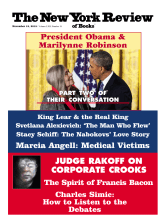In response to:
Max Planck: The Tragic Choices from the October 22, 2015 issue
To the Editors:
Freeman Dyson, in his review of Brandon R. Brown’s Planck: Driven by Vision, Broken by War [NYR, October 22], states that “Hitler won power in 1933 with solid public support, helped by a well-organized campaign of violence and intimidation.” He is certainly right about the latter, but on the former he is on less solid ground.
In the last German free election of November 6, 1932 (before Hitler was appointed chancellor by President von Hindenburg), the Nazis obtained 196 seats in the Reichstag versus 100 for the Communists and 121 for the Social Democrats. The results were similar in terms of total votes, the Nazis with 11.74 million (down from their high the previous July), the Communists with 5.98 million, and the Social Democrats with 7.24 million. Hitler was able to rule only with a coalition. Tragically, the two left parties were foes at the time. The next election, in March 1933, was a farce given the terror unleashed against the left. Nevertheless, even under the most dire conditions, the combined left still obtained more than 12 million votes against Hitler’s 17 million plus.
Martin Oppenheimer
Franklin Township, New Jersey
Freeman Dyson replies:
I am grateful to Martin Oppenheimer for providing the numbers of votes for and against Hitler in the 1932 and 1933 elections. The numbers confirm the fact that Hitler was elected by a solid plurality. In addition to the campaign of intimidation, there were other reasons for his victory. One reason was that he promised to put the country back to work, after long years of economic misery and high unemployment. He did what he promised, with the result that his public support endured.



